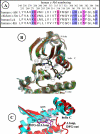Molecular dynamics simulations show that conformational selection governs the binding preferences of imatinib for several tyrosine kinases
- PMID: 20200154
- PMCID: PMC2859544
- DOI: 10.1074/jbc.M110.109660
Molecular dynamics simulations show that conformational selection governs the binding preferences of imatinib for several tyrosine kinases
Abstract
Tyrosine kinases transmit cellular signals through a complex mechanism, involving their phosphorylation and switching between inactive and active conformations. The cancer drug imatinib binds tightly to several homologous kinases, including Abl, but weakly to others, including Src. Imatinib specifically targets the inactive, so-called "DFG-out" conformation of Abl, which differs from the preferred, "DFG-in" conformation of Src in the orientation of a conserved Asp-Phe-Gly (DFG) activation loop. However, recent x-ray structures showed that Src can also adopt the DFG-out conformation and uses it to bind imatinib. The Src/Abl-binding free energy difference can thus be decomposed into two contributions. Contribution i measures the different protein-imatinib interactions when either kinase is in its DFG-out conformation. Contribution ii depends on the ability of imatinib to select or induce this conformation, i.e. on the relative stabilities of the DFG-out and DFG-in conformations of each kinase. Neither contribution has been measured experimentally. We use molecular dynamics simulations to show that contribution i is very small, 0.2 +/- 0.6 kcal/mol; imatinib interactions are very similar in the two kinases, including long range electrostatic interactions with the imatinib positive charge. Contribution ii, deduced using the experimental binding free energy difference, is much larger, 4.4 +/- 0.9 kcal/mol. Thus, conformational selection, easy in Abl, difficult in Src, underpins imatinib specificity. Contribution ii has a simple interpretation; it closely approximates the stability difference between the DFG-out and DFG-in conformations of apo-Src. Additional calculations show that conformational selection also governs the relative binding of imatinib to the kinases c-Kit and Lck. These results should help clarify the current framework for engineering kinase signaling.
Figures


Similar articles
-
Equally potent inhibition of c-Src and Abl by compounds that recognize inactive kinase conformations.Cancer Res. 2009 Mar 15;69(6):2384-92. doi: 10.1158/0008-5472.CAN-08-3953. Epub 2009 Mar 10. Cancer Res. 2009. PMID: 19276351 Free PMC article.
-
Computational analysis of the binding specificity of Gleevec to Abl, c-Kit, Lck, and c-Src tyrosine kinases.J Am Chem Soc. 2013 Oct 2;135(39):14741-53. doi: 10.1021/ja405939x. Epub 2013 Sep 20. J Am Chem Soc. 2013. PMID: 24001034 Free PMC article.
-
Conformation-selective inhibitors reveal differences in the activation and phosphate-binding loops of the tyrosine kinases Abl and Src.ACS Chem Biol. 2013 Dec 20;8(12):2734-43. doi: 10.1021/cb400663k. Epub 2013 Oct 29. ACS Chem Biol. 2013. PMID: 24106839 Free PMC article.
-
Overcoming kinase resistance in chronic myeloid leukemia.Int J Biochem Cell Biol. 2008;40(3):334-43. doi: 10.1016/j.biocel.2007.10.001. Int J Biochem Cell Biol. 2008. PMID: 18401881 Review.
-
Mechanisms of resistance to BCR-ABL and other kinase inhibitors.Biochim Biophys Acta. 2013 Jul;1834(7):1449-59. doi: 10.1016/j.bbapap.2012.12.009. Epub 2012 Dec 28. Biochim Biophys Acta. 2013. PMID: 23277196 Review.
Cited by
-
Insight on Mutation-Induced Resistance from Molecular Dynamics Simulations of the Native and Mutated CSF-1R and KIT.PLoS One. 2016 Jul 28;11(7):e0160165. doi: 10.1371/journal.pone.0160165. eCollection 2016. PLoS One. 2016. PMID: 27467080 Free PMC article.
-
Evolution and intelligent design in drug development.Front Mol Biosci. 2015 May 21;2:27. doi: 10.3389/fmolb.2015.00027. eCollection 2015. Front Mol Biosci. 2015. PMID: 26052517 Free PMC article.
-
Understanding biomolecular motion, recognition, and allostery by use of conformational ensembles.Eur Biophys J. 2011 Dec;40(12):1339-55. doi: 10.1007/s00249-011-0754-8. Epub 2011 Nov 17. Eur Biophys J. 2011. PMID: 22089251 Free PMC article. Review.
-
Structural and Dynamic Insights of the Interaction between Tritrpticin and Micelles: An NMR Study.Biophys J. 2016 Dec 20;111(12):2676-2688. doi: 10.1016/j.bpj.2016.10.034. Biophys J. 2016. PMID: 28002744 Free PMC article.
-
Tyrosine Kinase Activation and Conformational Flexibility: Lessons from Src-Family Tyrosine Kinases.Acc Chem Res. 2017 May 16;50(5):1193-1201. doi: 10.1021/acs.accounts.7b00012. Epub 2017 Apr 20. Acc Chem Res. 2017. PMID: 28426203 Free PMC article.
References
-
- Robinson D. R., Wu Y. M., Lin S. F. (2000) Oncogene 19, 5331–5340
-
- Hubbard S. R., Till J. H. (2000) Annu. Rev. Biochem. 69, 373–398 - PubMed
-
- Manning G., Whyte D. B., Martinez R., Hunter T., Sudarsanam S. (2002) Science 298, 1912–1934 - PubMed
-
- Pawson T., Nash P. (2003) Science 300, 445–552 - PubMed
-
- Kuriyan J., Eisenberg D. (2007) Nature 450, 983–990 - PubMed
Publication types
MeSH terms
Substances
LinkOut - more resources
Full Text Sources
Other Literature Sources
Miscellaneous

